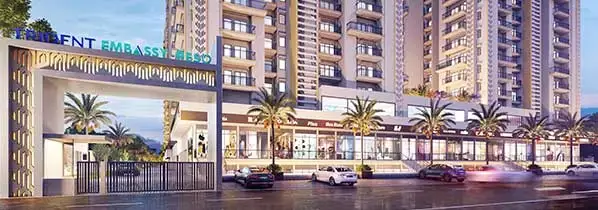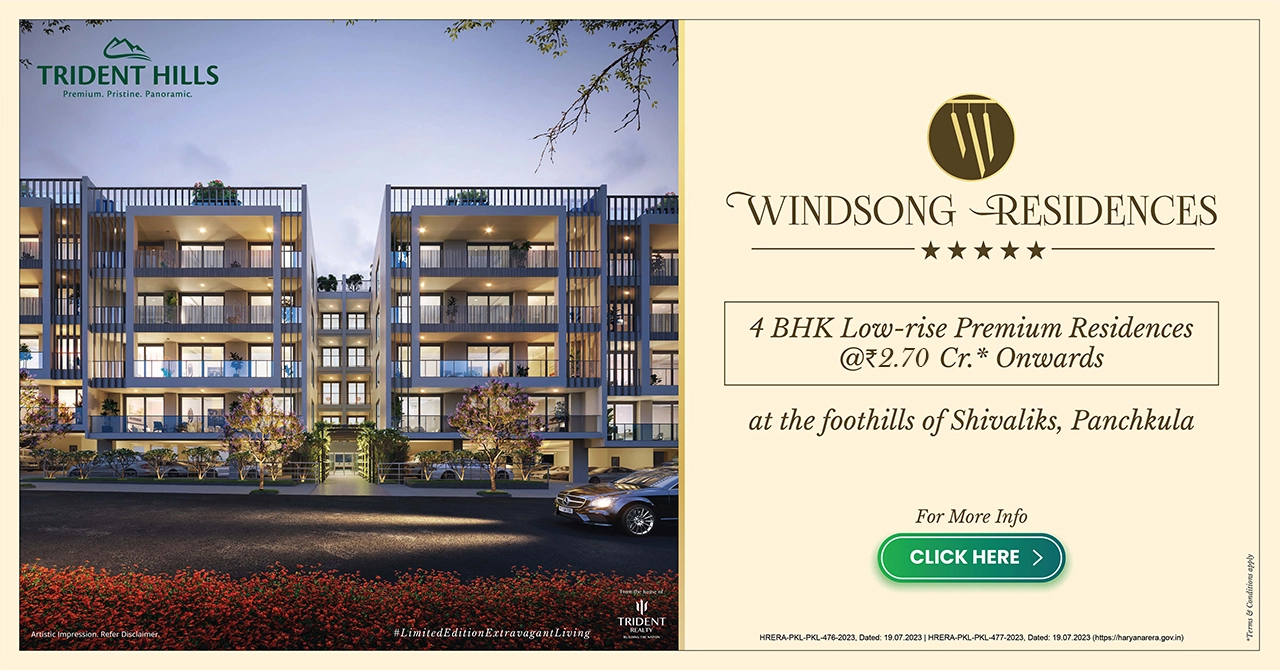
Smart Amenities That Define Modern Luxury Residences
The Indian real estate market is undergoing a transformative shift, where luxury transcends traditional opulence and expansive spaces. Today’s affluent buyers, including high-net-worth individuals (HNIs), non-resident Indians (NRIs), and urban professionals, demand residences that seamlessly integrate elegance with advanced technology. From AI-driven automation to wellness-focused infrastructure, smart amenities are redefining modern luxury living. Integrated townships, such as Trident Hills in Panchkula, Tricity, are leading this evolution by blending cutting-edge infrastructure with strong investment potential. This article explores how smart amenities are shaping buyer preferences and why projects like Trident Hills are at the forefront of India’s luxury real estate market.
The Rise of Smart Amenities in Luxury Residences
The post-pandemic era has reshaped the priorities of homebuyers. A JLL India report indicates that 68% of Indian homebuyers now prioritize homes with integrated smart features, a significant shift from pre-2020 trends. This reflects a growing demand for residences that offer convenience, security, and sustainability—qualities that resonate deeply with India’s affluent and tech-savvy population.
Smart amenities encompass a range of technologies designed to enhance the living experience, including:
Home Automation: Systems that control lighting, temperature, and appliances via smartphone apps or voice commands.
Smart Security: AI-powered surveillance, biometric access, and real-time monitoring for enhanced safety.
Wellness Infrastructure: Air purification systems, smart gyms, and wellness-focused community spaces.
EV-Ready Infrastructure: Charging stations for electric vehicles to promote sustainable mobility.
Touchless Technology: Voice-activated or sensor-based appliances to ensure hygiene and convenience.
As Knight Frank India notes, the luxury housing segment in India is projected to grow at a compound annual growth rate (CAGR) of 12.3% through 2027, driven by demand for tech-enabled features. This trend is particularly strong in Tier-2 cities, where buyers seek a balance of urban connectivity and tranquil, technology-enhanced living.
Why Smart Amenities Are Non-Negotiable in 2025
The integration of smart amenities has become a cornerstone of modern luxury residences. Several factors highlight their importance:
1. Evolving Lifestyle Expectations
Post-pandemic, Indian homebuyers prioritize homes that support hybrid work, wellness, and sustainability. A CBRE India survey found that 72% of luxury homebuyers prefer residences with smart home systems that enable remote management of utilities. Features like intelligent thermostats, automated lighting systems, and app-driven concierge services provide residents with seamless control and convenience.
2. Security and Safety Priorities
With increasing urbanization, security is a top concern. Smart security systems—featuring facial recognition, motion sensors, and real-time alerts—offer peace of mind for high-net-worth individuals (HNIs) and non-resident Indians (NRIs) investing in second homes. According to Anarock Research, 65% of premium homebuyers in Tier-2 cities prioritize integrated security systems, making them a critical differentiator for luxury projects.
3. Sustainability and Cost Efficiency
Smart amenities align with India’s push toward sustainability. Energy-efficient systems, such as smart meters and solar-powered common areas, reduce utility costs while minimizing environmental impact. A NAREDCO report highlights that green-certified buildings command a 5-10% price premium, reflecting buyer willingness to invest in sustainable living.
4. Investment Appeal for NRIs and HNIs
For NRIs and HNIs, smart amenities enhance a property’s long-term value. Properties equipped with advanced technology in Tier-2 cities are generating 15-20% higher rental yields compared to conventional residences, driven by demand for modern features. These smart infrastructures make such projects highly attractive for investors seeking both capital growth and rental income.
Smart Amenities in Action: Redefining Luxury Living
Luxury residences are incorporating smart amenities to create comprehensive, future-ready living environments. Leading developers are embedding technology to meet the evolving expectations of buyers. Examples include:
AI-Driven Clubhouses: Community spaces with app-based booking systems for facilities like gyms, pools, and event halls, streamlining resident experiences.
Integrated Smart Home Systems: Platforms that enable residents to manage lighting, security, and appliances through a unified interface, enhancing ease of use.
Wellness-Focused Design: Developments incorporating air purifiers, green spaces, and smart fitness centers to promote resident well-being.
These features reflect a broader industry trend where developers prioritize technology to align with buyer preferences. In Tier-2 cities, such as those in the Tricity region, these amenities are particularly impactful, offering a blend of urban sophistication and serene living.
Investment Potential in Tier-2 Cities
The Tricity region—comprising Chandigarh, Mohali, and Panchkula—is a prime example of a Tier 2 market with significant investment potential. According to Financial Express, Tricity’s real estate market is witnessing an annual price appreciation of 15-18%, driven by infrastructure upgrades such as the PR-7 Airport Road and NH-5 expansion. Integrated townships in this region are capitalizing on limited land availability and robust demand, with Anarock Research reporting an annual capital appreciation of 12-15% in the luxury segment.
For investors, these townships offer competitive entry points, with premium plots and residences catering to a diverse range of budgets. The region’s proximity to natural landmarks, coupled with its growing IT and commercial hubs, makes it a hotspot for NRIs seeking high-yield investments. Social media discussions highlight that NRIs are increasingly drawn to Tier-2 cities for their consistent returns and growth potential.
The Broader Indian Context: Luxury Goes Smart
India’s luxury real estate market is evolving rapidly, with Tier-2 cities playing a pivotal role. A JLL India report projects that India’s residential market will grow to $1.5 trillion by 2030, with smart homes accounting for 20% of new launches in premium segments. Key drivers include:
Shifting Buyer Priorities: Since 2021, there has been a 30% surge in demand for spacious, tech-enabled homes that support remote work and wellness, as buyers prioritize lifestyle and functionality.
Tier-2 City Growth: Cities such as Panchkula, Coimbatore, and Jaipur are attracting investment due to their affordable land prices and high growth potential. By 2030, Tier-2 cities are expected to account for 35% of India’s real estate expansion.
Policy Support: Government initiatives, such as the Smart Cities Mission and tax incentives for green buildings, encourage developers to integrate smart amenities. The RBI’s repo rate stability at 6.5% in 2025 further supports housing demand.
Integrated townships in Tier-2 cities are leveraging these trends, offering a blend of smart technology and sustainable urban planning that aligns with modern buyer expectations.
Challenges and Opportunities
While smart amenities enhance a project’s appeal, buyers should consider potential challenges:
Cost Implications: Integrating smart technology can result in increased upfront costs. However, developers are mitigating this by offering a diverse range of residential options, from plots to apartments, catering to a variety of budgets.
Technology Adoption: Some buyers may find smart systems unfamiliar, but developers are addressing this by incorporating intuitive interfaces and providing dedicated support to ensure ease of use.
Infrastructure Timelines: Delays in regional infrastructure projects, such as metro expansions, could impact short-term connectivity. However, strategic locations along major highways, as is common in the Tricity area, minimize this risk.
On the opportunity side, projections indicate that smart homes will command a 10-15% price premium by 2027, making early investments in tech-enabled projects highly lucrative.
The Future of Luxury Living
As India’s real estate market evolves, thoughtful amenities are redefining the concept of luxury living. Projects like Trident Hills, with their fusion of technology, sustainability, and prime location, are setting new standards for future-ready residences. For investors, the township presents a unique opportunity to capitalize on Tricity’s growth trajectory, driven by a limited land supply and strong demand. For homebuyers, it delivers a lifestyle that blends convenience, security, and wellness in a tranquil, nature-rich environment.
In 2025, with the luxury market in Tier 2 cities becoming increasingly competitive, Trident Hills stands out as a prime choice for forward-thinking homeowners and investors seeking to secure long-term wealth. As the boundaries between technology and luxury continue to blur, townships like Trident Hills are gateways to a smarter, more aspirational future.









